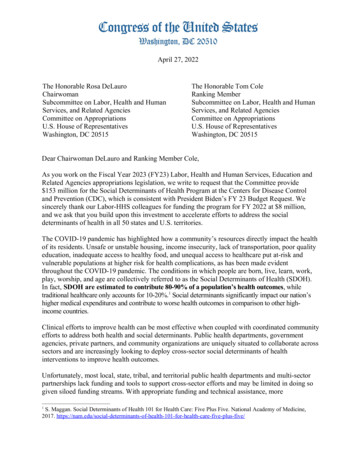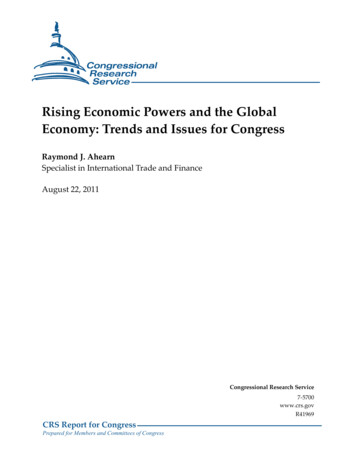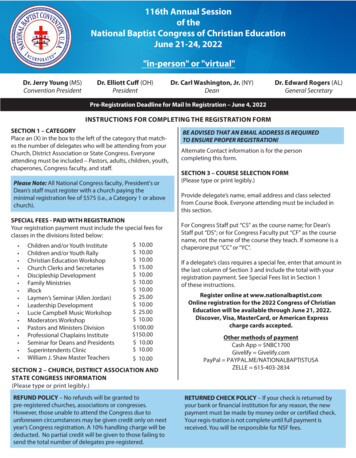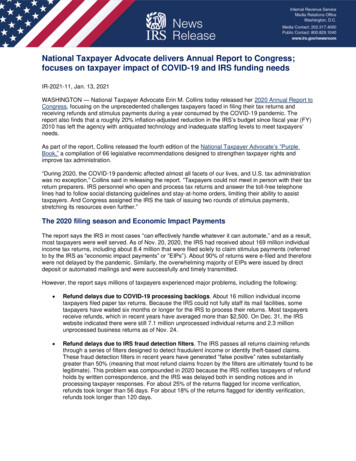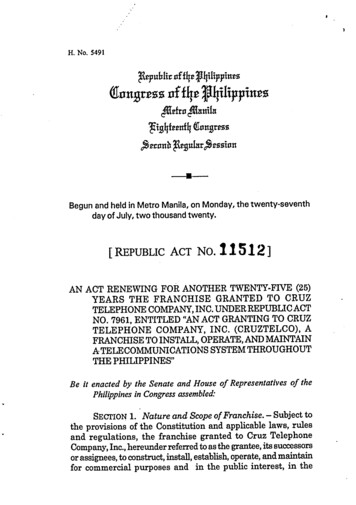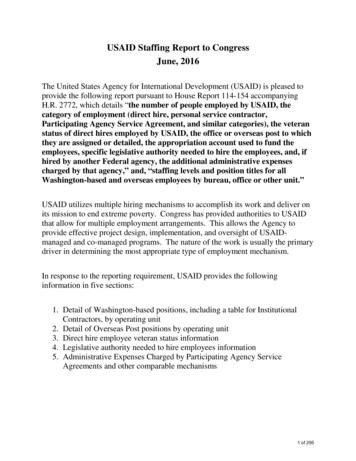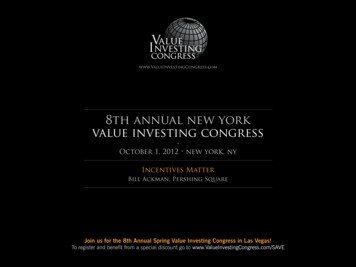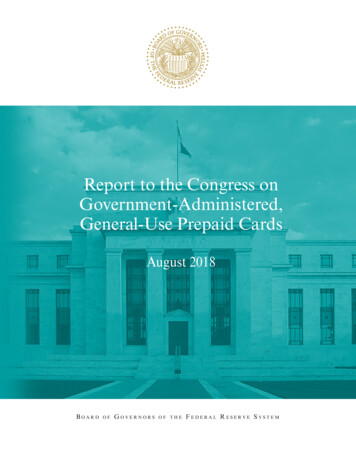
Transcription
Report to the Congress onGovernment-Administered,General-Use Prepaid CardsAugust 2018BOARDOFGOVERNORSOF THEFEDERAL RESERVE SYSTEM
Report to the Congress onGovernment-Administered,General-Use Prepaid CardsAugust 2018BOARDOFGOVERNORSOF THEFEDERAL RESERVE SYSTEM
This and other Federal Reserve Board reports and publications are available online To order copies of Federal Reserve Board publications offered in print,see the Board’s Publication Order Form (www.federalreserve.gov/files/orderform.pdf)or contact:Printing and FulfillmentMail Stop K1-120Board of Governors of the Federal Reserve SystemWashington, DC 20551(ph) 202-452-3245(fax) 202-728-5886(email) Publications-BOG@frb.gov
iiiContentsBackground . 1Analysis of 2017 Data. 3Prevalence of Use: Prepaid Card Disbursements . 3Fees Collected and Paid by Issuers . 3
1BackgroundFederal, state, and local government offices use prepaid cards to disburse funds at a lower cost thanchecks (or other paper-based payment instrumentssuch as vouchers or coupons) and to provide analternative to direct deposit for payment recipients,especially those recipients who do not have bankaccounts. As a result, government offices contractwith financial institutions to issue prepaid cards, disburse program funds, and provide customer service.1burse funds in calendar year 2017.3 All issuersresponded, reporting data for roughly 3,000 programs.4 The Board also collected a limited amountof prevalence-of-use data from the U.S. Treasury, theU.S. Department of Agriculture, and three nonbankfinancial institutions that process electronic benefittransfer (EBT) transactions.5 The data collected represent programs from all 50 states and the District ofColumbia.Section 1075 of the Dodd-Frank Wall Street Reformand Consumer Protection Act, which added section 920 to the Electronic Fund Transfer Act,requires the Federal Reserve Board (Board) to reportannually to the Congress on the prevalence of use ofgeneral-use prepaid cards in federal, state, and localgovernment-administered payment programs and onthe interchange fees and cardholder fees chargedwith respect to the use of such cards.2Across reported programs, government offices disbursed 144 billion through prepaid cards in 2017, aroughly 1 percent decrease from 2016. Prepaid carddisbursements in state and local programs declinedduring this period driving the decrease, somewhatoffset by increases in federal programs.3The Board distributed a survey to 19 issuers to collect prevalence-of-use and fee data on federal, state,and local government-administered payment programs that used prepaid cards as a method to dis12Occasionally, third-party program managers are involved ingovernment prepaid card programs. Issuers often contract withprogram managers to provide services traditionally carried outby the issuer. In certain cases, a program manager contractsdirectly with the government office and provides almost allfunctions that are traditionally carried out by an issuer.See “Government-Administered, General-Use Prepaid Cards”on the Board’s website at paid-executive.htm.A program is considered government-administered regardlessof whether a federal, state, or local government office operatesthe program or outsources some or all functions to third parties, so long as the program is operated on behalf of a government office. In addition, a program may be governmentadministered even if a federal, state, or local government officeis not the source of funds for the program it administers. Forexample, child support programs are government-administeredprograms even though they are funded by individuals.45“Government-Administered, General-Use Prepaid Card Survey—Issuer Survey,” FR 3063a, OMB No. 7100-0343, FederalReserve Board website, a government issuer survey2017.pdf. The FR 3063a survey is conducted annually to collectinformation for this report. The Board identified issuers to survey by consulting with relevant payment card networks (PCNs).The Board reviewed the data submitted by survey respondentsfor completeness, consistency, and anomalous response. Wherepossible, the Board resolved identified issues by following upwith respondents and by replacing problematic data elementswith imputed values. In computing a given summary statisticfor this report, the Board excluded responses with unresolvedissues that affected the calculation’s inputs. Although the Boardmakes a comprehensive effort to identify and resolve issues inthe reported data, some issues may not have been identified bythe time this report was published.The pool of reported programs changes over time because government agencies may add or eliminate programs and may alterdisbursement methods for existing programs. Issuers selfreported the number of programs included in their responses.Some issuers were unable to distinguish between multiplegovernment-administered payment programs that disbursefunds on the same card. The number of programs, therefore,represents a lower-bound approximation. Issuers occasionallypartner with third-party program managers that contractdirectly with government agencies. In these cases, issuers maynot have access to some data requested in the survey.Program counts were not available from these organizations.
3Analysis of 2017 DataPrevalence of Use: Prepaid CardDisbursementsData highlights for 2017government-administered general-useprepaid card disbursementsFor calendar year 2017, government agencies disbursed 144 billion through prepaid cards acrossreported programs.6 Total funds disbursed throughprepaid cards varied widely by program type, asshown in figure 1. Consistent with years prior, theSupplemental Nutritional Assistance Program(SNAP) disbursed the largest share of total fundsthrough prepaid cards across all reported programsin 2017. In total, these prepaid disbursements represent approximately 2.3 percent of total governmentexpenditures in 2017.7 Disbursements to prepaid cards decreased roughly1 percent between 2016 and 2017, from 146 billion to 144 billion.67 The 1 percent decrease in total disbursement offunds reflects a 4 percent decrease, from 112 billion to 107 billion, in state and local disbursements and a roughly 8 percent increase, from 34 billion to 37 billion, in federal disbursements.Fees Collected and Paid by IssuersIssuers largely receive revenue by collecting interchange fees and cardholder fees.8 Transactions madeFunds disbursed onto prepaid cards but ultimately returned togovernment agencies are excluded from this figure. The value offunds returned to government agencies is de minimis.“Table 3.1. Government Current Receipts and Expenditures,”U.S. Department of Commerce, Bureau of Economic Analysis,last modified May 30, 2018, www.bea.gov/national/pdf/SNTables.pdf. Total government expenditures include expenditures of federal, state, and local governments in calendar year2017.8An interchange fee is any fee established, charged, or receivedby a PCN and paid by a merchant or a merchant acquirer forthe purpose of compensating an issuer for its involvement in anelectronic debit transaction. 12 CFR 235.2(j). Merchant acquirers typically pass the cost of these fees on to merchants. Inter-Figure 1. Funds disbursed through prepaid cards in 2017, by program type 64.2SNAP 34.7Social Security 19.9Unemployment 13.3Child support 6.4Cash assistance 2.6OtherWICVeterans 1.2 1.0Payroll 0.4Tax refund 0.2010203040506070Billions of dollarsNote: Cash assistance includes Temporary Assistance for Needy Families, Low Income Home Energy Assistance Program, child care, refugee assistance, and general assistanceprograms.
4Report to the Congress on Government-Administered, General-Use Prepaid Cardsusing government prepaid cards are generally exemptfrom the interchange fee standards of Regulation II.9For cardholder fees, government offices negotiaterates for each program with issuers. Governmentoffices also often restrict the number and type ofcardholder fees an issuer can charge. In 2017, issuersreported collecting 333 million in interchange feesand 153 million in cardholder fees.10 In addition tocollecting fees, issuers must also pay fees to third parties for various services, such as cardholder cashwithdraws from an out-of-network automated tellermachine (ATM) or bank.1191011change fees, in effect, are a cost to merchants and a source ofrevenue to issuers.For definitions of the various cardholder fees mentioned in thisreport, see “Government-Administered, General-Use PrepaidCard Survey—Issuer Survey,” FR 3063a, OMB No. 7100-0343,Board, agovernment issuer survey 2017.pdf.Less commonly, issuers also receive incentive payments fromPCNs and fees from government offices for providing prepaidservices. Incentive payments are payments received by an issuerfrom a PCN with respect to debit card transactions or debitcard-related activity. Issuer incentives may be based on reachingspecified volume levels, promoting the network’s brand throughmarketing activities, converting the issuer’s debit card base to adifferent network, or undertaking other activities. Incentivepayments do not include payments from a network to an issuerfor traditional banking services the issuer provides to the network (for example, transaction account services to the network). Issuers may also receive revenue from interest on program funds held in pooled bank accounts before the beneficiaries use them; however, the Board does not gather data on thissource of revenue.Regulation II limits the amount of interchange fees an issuercan collect with respect to electronic debit transactions. 12 CFR235.3. The average interchange fee as a percentage of purchasetransaction value for government prepaid card transactions issimilar to that for all debit card transactions exempt from theinterchange fee caps of Regulation II.Consistent with previous reports, the Board calculated all revenue figures here using data collected through the issuer surveyon the population of network-branded governmentadministered, general-use prepaid cards (excluding EBT cards).For EBT card programs, states generally pay an issuer or processor based on the number of beneficiaries enrolled in a program per month, in part because there are no interchange feesassociated with these card programs. Certain cardholder fees,such as a fee for card replacement, may also apply to EBTprograms.Issuers pay fees to ATM operators for each ATM cash withdrawal to compensate the operator for the costs of deployingand maintaining the ATMs and of providing cash services tothe issuers’ cardholders. Issuers pay fees to banks for each OTCcash withdrawal to compensate the bank for the costs of staffing the teller window and providing cash services to the issuers’cardholders. In addition to ATM and OTC fees, issuers pay feesto PCNs (such as switch, license, and connectivity fees); however, the Board does not collect data for these fees in relation togovernment-administered prepaid cards.Data highlights for 2017government-administered general-useprepaid card fees Interchange fee revenue increased about 1 percentbetween 2016 and 2017, from 328.2 million to 332.6 million. The average value of purchase transactiondecreased 48 cents between 2016 and 2017, from 30.29 to 29.81. During the same period, the average interchange fee per purchase transactionremained constant at 0.34.12 The average interchange fee as a percentage ofpurchase transaction value remained constant at1.0 percent for federal programs and 1.2 percentfor state and local programs between 2016 and2017.13 Total cardholder fee revenue decreased 3.3 percentbetween 2016 and 2017, from 158 million to 153 million. In 2017, total cardholder fee revenuerepresented 0.2 percent of program funds disbursed onto prepaid cards. Cardholder ATM fees and cardholder account servicing fees represented the two largest sources ofcardholder fee revenue for issuers in 2017, representing 85.7 million and 42.3 million, respectively. These fees represent 85 percent of total cardholder fee revenue. See figure 2 for total revenueissuers collected and the average charge per occurrence by cardholder fee type in 2017.14 Issuers reported paying approximately 66 millionin fees to third parties for ATM withdrawals and 22 million in fees to third parties for over-thecounter (OTC) cash withdrawals.1512131415The Board calculated average value of purchase transaction asthe quotient of the value of settled purchase transactionsdivided by the number of settled purchase transactions.The Board calculated average interchange fee per purchasetransaction as the quotient of total interchange fees divided bythe number of settled purchase transactions.The Board calculated average interchange fee as a percentage ofpurchase transaction value as the quotient of total interchangefees divided by the value of settled purchase transactions.The Board excluded transactions for which no fee was assessedfrom the average fee calculations.On average, issuers paid approximately 97 cents per ATM cashwithdrawal and 3.43 per OTC cash withdrawal in 2017.Because of limited data, the Board approximated the numberof ATM and OTC withdrawals resulting in a fee. Therefore, thecalculations of average ATM and OTC fees paid by issuers areestimates.
August 2018Figure 2. Cardholder fees: revenue and average fee charged in 2017, by type of fee7Average fee (dollars) 2.5M654 0.7M 42.3M3 85.7M21 0.4M 2.5M 13.2MPenaltyCustomerserviceinquiry Note: Size of bubble represents total revenue from fee.Position of black dot on vertical-axis represents average fee when charged.AccountservicingATM5
www.federalreserve.gov0818
prepaid cards varied widely by program type, as shown in figure 1. Consistent with years prior, the Supplemental Nutritional Assistance Program (SNAP) disbursed the largest share of total funds through prepaid cards across all reported programs in 2017. In total, these prepaid disbursements repre-sent approximately 2.3 percent of total government


